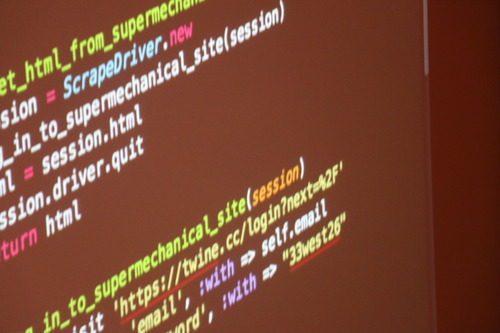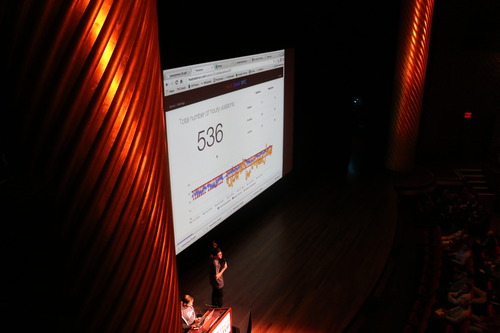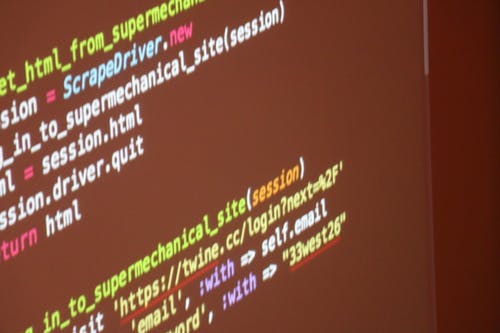Four months ago, Tristan Siegel was an aspiring archeologist and William Jeffries was an accountant. Fresh out of Flatiron School’s Web Development course, they’re already out to make something that matters. They started building Heat Seek NYC to help address the need for livable heating in NYC’s lowest-income apartments. As they learned, Landlords can lower the heating far below room temperatures in their buildings to save money or drive out poorer tenants. Heat Seek NYC helps validate tenants’ claims against their landlords with the power of cold hard data—and gives tenants agency over their living environments.
William and Tristan Present Heat Seek NYC at New York Tech Meetup
After an inundation of support at NY Tech Meetup, William and Tristan are leveraging their newly found community to make their app bigger and better. They’ve learned a lot (everything from brand new technologies to socio-political landscapes of underserved areas) to make Heat Seek NYC what it is now. But they also recognize that, for their app to make a difference to whole communities, they’ve got plenty of work ahead of them. Read the full interview here.
How it Works
Heat sensors—a technology called Twine—in tenants’ apartments collect temperature data. Heat Seek NYC scrapes the recorded information from Twine’s site, including every hour the temperature is below the legal limit, and displays it all in charts and graphs that tenants can print out and take to court.

Highlights
William and Tristan presented Heat Seek NYC at NY Tech Meetup, where they referenced “algorithmic advocacy”—or automating the advocacy process to make technology more useful for underserved communities. They found that tenants are usually advised to just write down temperatures and testify that they’re accurate, which leaves a lot room for bias and error in tenants’ claims. “Judges just don’t take these claims very seriously. Algorithmic advocacy means automating advocacy and using to technology to stand up for people who need standing up for.”
Armed with real, objective data, the app can remove hearsay associated with temperature readings by having a third party control them. It measures, records, and presents temperatures automatically and without human involvement to ensure the data tenants get is accurate and holds up in court.
“Algorithmic advocacy means automating advocacy and using technology to stand up for people who need standing up for.”
To make sure they collect the data that best supports tenants’ claims, the pair are partnering with the Urban Justice Center—an organization that does non-profit legal work for people in lower income areas. The UJC was so excited about the technology that they’ve advised on everything from modeling data to constructing user flows. With the help of the UJC, tenants and lawyers can login to Heat Seek, and get the kinds of data judges are familiar with as easily as possible.

What’s Next
For proof concept, Heat Seek NYC has already been installed in three apartments—one in the South Bronx and two in Crown Heights—and William and Tristan are currently researching funding methods and technologies that will make it possible to put their technology in even more homes.
“We want to get the app right first, but we’re currently working with a hardware specialist to figure out what the best product is, then the best way to scale it.”
This includes, according to William, “researching hardware options to make things cheap enough to scale up. We want to get the app right first, but we’re currently working with a hardware specialist to figure out what the best product is, then the best way to scale it.”
They’re also building out a team to make Heat Seek NYC for the NYC Big Apps competition. So far, the core team comprises six people, including designers, hardware specialists, and business development people. William feels like the benefits are already clear.
“We’ve already seen the benefits of building a team in meetings, direction, and efficiency in general. We did it to build a better product.”
Keep an eye out for Heat Seek NYC in NYC Big Apps—a competition that brings NYC’s sharpest minds to solve it’s biggest challenges. We’re really excited to see where it goes. Read our full interview with William Tristan here.
The Stack
Heat sensing with Twine
Developed in Ruby on Rails
Deployed to Digital Ocean
PostGreSQL on the backend
Served with Passenger
Data mapped with LeafletJS
Charts from Highcharts with gem wrapper Chartkick
Scraped by Poutergeist, PhantomJS, and Capybara




